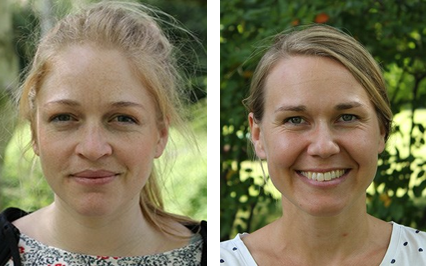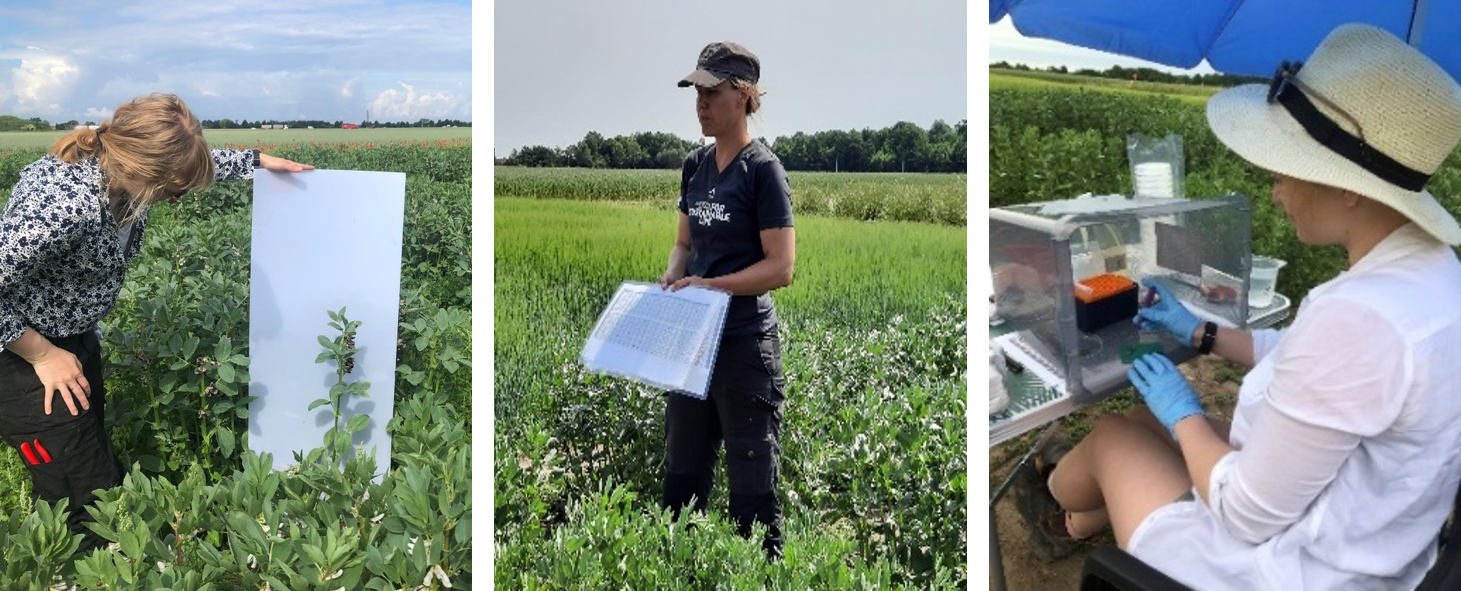Dr. Hannah Ohm and Dr. Åsa Grimberg are two of the authors of the paper "Novel SNP markers for flowering and seed quality traits in faba bean (Vicia faba L.): characterization and GWAS of a diversity panel". This study was conducted at SITES Lönnstorp Research Station during 2021-2022. In this piece, the authors share their insights with the SITES Community about the project and their experiences conducting research at a SITES station.

Dr. Hannah Ohm (left) and Dr. Åsa Grimberg (right)
Why is it important to investigate phenotypic diversity in target traits of Vicia faba?
Investigating phenotypic diversity in Vicia faba is crucial for harnessing its untapped potential in sustainable agriculture and plant-based food systems. Despite its high seed protein content and environmental benefits as a legume, V. faba suffers from unstable yields, susceptibility to pests and diseases, and antinutritional compounds. Characterizing phenotypic diversity enables identification of desirable traits such as improved seed quality, yield stability, flowering time, and resistance to pests like the broad bean weevil. Furthermore, understanding trait correlations and variation across breeding categories supports more informed selection and genetic improvement strategies in this partially allogamous crop, whose domesticated diversity remains largely underutilized due to limited phenotypic and genotypic characterization.
What are the main findings of your project?
The project established a well-characterized diversity panel of 220 Vicia faba accessions from global origins.
- Eleven agronomic and seed quality traits were phenotyped over two years in Nordic field conditions at SITES Lönnstorp, revealing high heritability and substantial genotypic variation.
- Yield was positively correlated with plant height, seed number, and maturity, while protein content was independent of yield but negatively correlated with starch content.
- Early-flowering and large-seeded accessions were more susceptible to bean weevil infestation.
- A genome-wide association study identified 51 significant SNPs associated with ten traits, including flowering time, maturity, seed size, yield, and weevil resistance.
- Genetic markers were successfully mapped to the new V. faba reference genome, and marker–trait associations corresponded to genes with known regulatory functions in other legumes.
How can the results be applied in society and be utilised by different stakeholders?
The identified phenotypic diversity and molecular markers provide valuable tools for breeders aiming to improve V. faba cultivars tailored to sustainable food production. Stakeholders such as plant breeders, gene banks, seed companies, and policymakers can:
- Evaluate the SNP markers for use in marker-assisted selection to accelerate breeding for high-yielding, early-maturing, or high-protein varieties.
- Develop regionally adapted cultivars using accessions identified as particularly promising for Nordic latitudes.
- Leverage the data to support crop diversification strategies aimed at reducing reliance on soy and synthetic fertilizers.
- Encourage cultivation of V. faba through policy incentives and investment in breeding programs aligned with environmental and nutritional goals.
Has a collaboration with other researchers, research groups, stakeholders and companies taken place?
Yes, the project was conducted within the framework of SLU Grogrund, a national centre for plant breeding of food crops that connects academic research with industry. This network provided access to numerous stakeholders and industrial collaborators, including Lantmännen, with whom we maintained close contact throughout the project. Accessions were sourced globally, including contributions from multiple international gene banks (NordGen, IPK, USDA). The project also hosted field visits for researchers and media, helping to raise awareness of the crop and the challenges it faces.

Dr. Hannah Ohm and Dr. Åsa Grimberg during fieldwork at SITES Lönnstorp Research Station (Photo: H. Ohm & Å. Grimberg)
What has been done at SITES Lönnstorp?
Field trials were conducted over two growing seasons (2021–2022) with the full V. faba diversity panel to assess agronomic and seed quality traits under field conditions.
What worked best and what were the challenges?
The collaboration with SITES staff was highly efficient; they prepared the field for sowing, took soil samples and supported additional tasks such as weeding, watering, and bird protection measures during the season. Challenges were primarily due to weather and bird damage.
What support have you received from the staff?
Support included field maintenance, ad hoc assistance with crop management, and logistical help during fieldwork.
What is the added value of performing data collection at SITES?
The site provided facilities for seed drying and other practical needs (e.g. lunch room, sanitation), and the experienced staff and available equipment greatly facilitated field operations.
Have you used the stations' long-term data series?
Yes, weather data from the station were incorporated into the phenotypic analysis.
Were your expectations met? Any unexpected events?
Expectations were met. Some unforeseen events (e.g. bird attacks) occurred, but these were unrelated to the SITES infrastructure or protocols.
Suggestions for complementary functions at SITES?
Additional phenotyping equipment and infrastructure (e.g. measuring equipment, imaging systems, drones, automated sensors) could further enhance its utility as a plant research hub.
How could SITES be developed further?
By integrating high-throughput phenotyping technologies, expanding digital infrastructure, and strengthening dissemination of results to broader research and breeding communities.